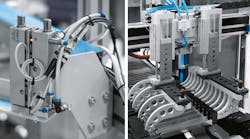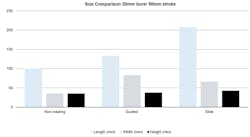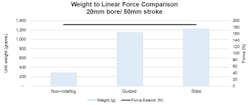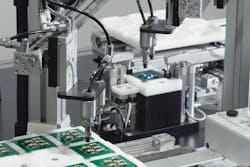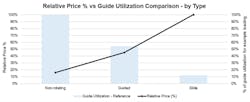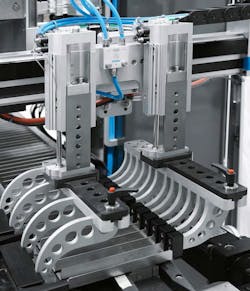At a Glance:
- Guided drives have the power to handle lifting, pressing, pulling, pushing, clamping, stopping, holding, cutting and separating.
- Guided slides do well when precision and repeatability are required.
- Guided slides and drives can be used in a wide range of pack-and-place applications.
Pneumatic guided drives and slides are the workhorses of industrial automation. They are well-proven and can adapt to a growing range of applications in which adding guidance improves performance. They are cost-effective as well, with many variants and configuration options to assure great reliability and longevity.
Drives and Slides
Unlike standard drives, pneumatic guided drives maintain complete stability and pneumatic guided slides provide greater stability and precision, all of which is critical in many pick-and-place functions. With both types of actuators, adding stabilization for the piston rod ensures better performance and a longer service life than the non-stabilized alternatives. The market for guided drives and slides is growing as more engineers learn it is easier and more convenient to buy a single product with linear movement and guidance rather than buying both functions separately.
In a standard pneumatic drive, the piston rod creates linear motion and can freely rotate as it extends and retracts. In many industrial applications, that rotation is immaterial; but it is unwanted if the user needs stability, such as maintaining a stamping tool perfectly parallel to the item being stamped. Additionally, if the piston rod applies force on an object, the resistance it meets can create a lateral force or torque against the actuator assembly.
For example, if the actuator is positioning a circular saw cutting through wood, external forces on the actuator when the piston rod is extended can create deflections that cause an imperfect cut. This generates excessive wear on the saw and cylinder.
Pneumatic guided drives have just one piston, with the piston’s stability guaranteed by two guide rods. These guide rods typically run on sets of bushings or ball bearings for stability. The guide rods and piston attach to a yoke that holds tooling, preventing the piston from twisting or turning if lateral force is applied for operational stability. These drives are found in applications involving lifting, pressing, pulling, pushing, clamping, stopping, restraining, holding, cutting and separating. They come in many sizes and variants, can hold almost any tooling, deliver stroke lengths up to 400 mm and can apply great force where required.
Guided slides excel in tasks where high levels of precision and repeatability are essential, such as in assembling electronics or small auto parts, in food and beverage handling, and in dispensing applications in other process sectors. Guided slides typically have single or dual piston rods and a guiding rail running on precision ball bearings in the slide housing for precise movement and repeatable accuracy, despite lateral loads and torques.
The slides provide the linear motion, whether fixed horizontally or vertically. They make excellent tools attached to a gantry, such as a dual axis (X, Z) multi-slide configurations and can be added to pick-and-place and piggyback configurations which have one slide mounted atop another for longer strokes with stops along the way, often without adapters.
In duplex applications, a compact mini-slide attached to a small mechanical gripper or a vacuum cup typically delivers a repeatable accuracy of 0.01 mm and linearity and parallelism within the 1/100 mm 0.01-mm range over millions of cycles.
Guided slides come in a range of sizes with different mounting options and many damping choices to assure the shortest cycle times with minimum vibrations. In apples-to-apples comparisons between guided slides and drives and not-rotating cylinders with identical piston bore size and stroke length, guided slides are the largest and heaviest of the options with built-in piston guidance, thanks to their wide, flat guides that deliver highly precise motion.
Assuming the same bore diameter (20 mm) for the piston rod and the same stroke length (50 mm), the guided slide has the largest profile (footprint or length, height and width). Guided drives fit in-between, being smaller than a guided slide and larger than a non-rotating cylinder.
Comparing a non-rotating cylinder, guided drive and a guided slide, all with the same piston bore size (20 mm), stroke length (50 mm) and an extended force of 188 N (see graph) the non-rotating drive’s force-to-weight ratio is 65%, the guided drive’s is 16% and the guided slide's 15%. So, a non-rotating cylinder would be smaller and less-expensive, but for higher torque load capacities or precision, a guided slide or drive is needed and they would be larger for the same bore/stroke. Adding guidance adds more weight relative to the non-rotating drive to provide more stability.
Alternatives to Guided Actuators
Non-rotating cylinders and combinations of external guides and standard cylinders are often considered alternatives to pneumatic guided drives and slides. They have limited load capacities, so they are better suited for applications that require maintaining a specific orientation but with small loads.
Non-rotating drives and cylinders with non-rotating piston rods are less expensive, but guided drives and slides are more durable and precise and can handle higher lateral loads and torque. When performing the same function, such as lifting a load or moving a gripper, the non-rotating drive will have the greatest amount of deflection from bearing clearance and lateral force. Deflection in this case is the distance the piston or front plate moves due to play with the bearings or any external forces. Increased deflection means decreased precision.
An external guide can be matched with a larger range of cylinders to handle a variety of tasks and situations such as clamping, adjustable air cushions and working in high temperatures, but the two must be connected. Guided slides and drives have fewer configuration options and a more-limited performance envelope, but they are also less expensive. In pick-and-place applications, a compact unguided cylinder with its freely rotating piston might be considered, but it will not assure consistent positioning and orientation of parts being moved as well as a guided mini-slide would.
Pneumatic and Electrical Guidance
Pneumatic and electric guided drives and slides can perform similar missions but have different strengths. With a properly scaled, well-maintained compressed air source, pneumatic drives deliver higher force densities and speeds for lower installation and operating cost, along with longer service lives.
Comparing actuators in similar pneumatic and electric mini-slides, the pneumatic version is shorter with shorter positioning times. Electric versions offer gentler stopping and starting, a programmable drive profile and constant, precise speeds. As a general rule, pneumatic drives and slides take up less space. Today, energy management and compressed air diagnostics can reduce air use and unscheduled maintenance and downtime, making them a more economical choice.
Relative efficiency is a prime consideration in making the right engineering choice among potentially suitable pneumatic drives with guiding.
The example (below) compares prices of a non-rotating cylinder, guided drive and a guided slide (all base models with the same 20 mm piston and 50 mm stroke), and the percentage of the guide used when subjected to identical offset loading conditions. For the purpose of this example, the non-rotating cylinder is at 100% guide use. It is at its limit and a poor choice in terms of its ability to handle offset loading. The guided slide is the most expensive of the three, and with just 12% guide use, it over-performs for this application. The guided drive achieves 54% guide use, and although it’s about 2.5× the cost of the non-rotating cylinder, it provides the best cost-performance of the three options.
Guided Drives for All Scenarios
Growth in the use of pneumatic guided drives and slides reflects their usefulness for an extraordinary range of tasks. These actuators are available in off-the-shelf as well as specialty or customized models, and in metric and inch versions.
Off-the-shelf models account for half of the market and are cost-effective for most applications. Most are maintenance-free and require little or no assembly. Many are available with a choice of plain-bearing guides for high rigidity or recirculating ball-bearing guides for applications with torque loads. Base models are extremely versatile and take up less space for the forces they deliver than the alternatives. These basic drives come in many sizes, with many piston diameter and stroke length combinations. Stroke lengths up to 200 mm are generally considered standard products. Larger versions with stroke lengths of up to 400 mm are available. These larger versions include a choice of damping and end cushioning options, including manually adjustable and, in some models, self-adjusting air cushioning.
There also are specialty models and variants for dry food and splash zones, clean room and ATEX applications, and variants with heat-resistant designs. Hygienic drives for food and pharmaceutical applications provide the same easy cleaning and corrosion resistance as standard hygienic cylinders as well as NSF-H1 compliant lubrication. Hygienic guided drives have a smooth, clean design that will not let water, dirt or dust collect on them.
Many of the same benefits of large, guided drives are available in mini-guided drives where short stroke length and less force are sufficient and space is at a premium. Particularly compact models offer stroke lengths of just 5-30 mm.
Guided slides offer similar variety with both standard and specialty models and options that can be adjusted for most applications. The range includes base models with stroke lengths up to 200 mm and multiple cushioning options, flat and slim designs, and ultra-compact models as small as 8-mm wide with 1 to 10-mm stroke lengths. The latter is ideal for small pick-and-place and other short stroke applications. The development of ever more compact guided slides reflects the industry trend, especially in electronics assembly, toward miniaturization which requires guided mini-slides and micro-slides perform with the same precision, repeatability and long service life of larger actuators.
Choosing the Right Drive
Software like Festo’s pneumatic sizing tool (found in the company’s online catalog under the blue “Engineering” tab) supports customers in the selection and configuration of pneumatic products. Customers can enter their application parameters, factors such as the load to be moved, the distance and speed, and the operating pressure. They are provided with suitable product recommendations, as well as an idea of the type of cushioning that meets their needs—from a simple bumper type or shock absorber to manually adjustable or self-adjusting air cushioning. That sizing tool also addresses bearing guide use, providing an indication of whether plain bearing or ball bearing styles would be better-suited to their operating requirements.
Demand for pneumatic guided drives and slides is growing steadily, reflecting the further expansion of automation and improvements in actuator design. These actuators are an excellent choice wherever compressed air energy is available. They are cost-competitive, easy to configure and install, often maintenance-free and robust, ensuring a long service life. They are versatile and available in a huge range of piston sizes and stroke lengths, with base models to suit most applications and specialty variants for many others. Their guiding capability is already designed and built-in, so minimal if any assembly is required. It’s no exaggeration that there is a guided drive or slide for most applications requiring stability and/or repeatable precision.
Darren O’Driscoll, Michael Guelker and Julian Beckler are product managers, and Thomas Martin heads product management (piston rod actuators), at Festo AG & Co.
